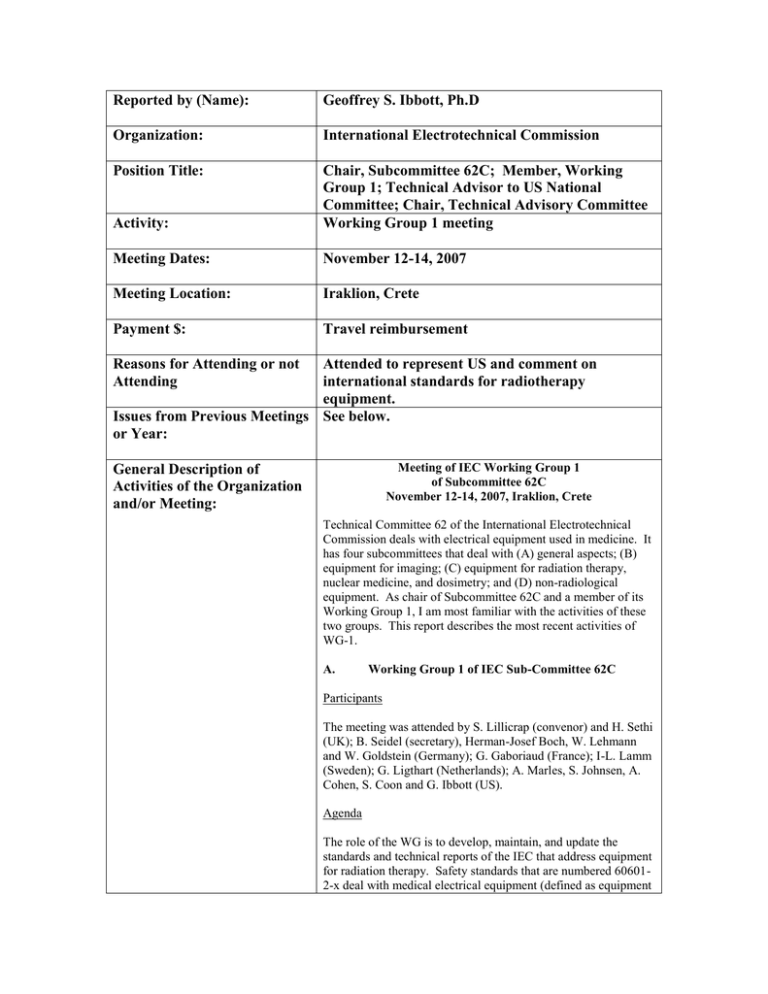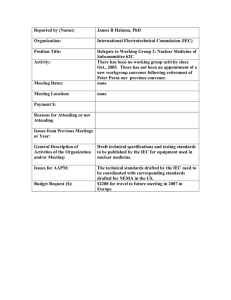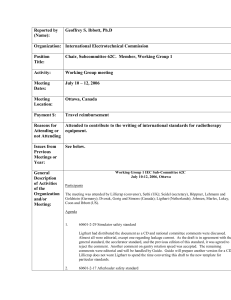Reported by (Name): Geoffrey S. Ibbott, Ph.D Organization:
advertisement

Reported by (Name): Geoffrey S. Ibbott, Ph.D Organization: International Electrotechnical Commission Position Title: Activity: Chair, Subcommittee 62C; Member, Working Group 1; Technical Advisor to US National Committee; Chair, Technical Advisory Committee Working Group 1 meeting Meeting Dates: November 12-14, 2007 Meeting Location: Iraklion, Crete Payment $: Travel reimbursement Reasons for Attending or not Attending Attended to represent US and comment on international standards for radiotherapy equipment. Issues from Previous Meetings See below. or Year: Meeting of IEC Working Group 1 of Subcommittee 62C November 12-14, 2007, Iraklion, Crete General Description of Activities of the Organization and/or Meeting: Technical Committee 62 of the International Electrotechnical Commission deals with electrical equipment used in medicine. It has four subcommittees that deal with (A) general aspects; (B) equipment for imaging; (C) equipment for radiation therapy, nuclear medicine, and dosimetry; and (D) non-radiological equipment. As chair of Subcommittee 62C and a member of its Working Group 1, I am most familiar with the activities of these two groups. This report describes the most recent activities of WG-1. A. Working Group 1 of IEC Sub-Committee 62C Participants The meeting was attended by S. Lillicrap (convenor) and H. Sethi (UK); B. Seidel (secretary), Herman-Josef Boch, W. Lehmann and W. Goldstein (Germany); G. Gaboriaud (France); I-L. Lamm (Sweden); G. Ligthart (Netherlands); A. Marles, S. Johnsen, A. Cohen, S. Coon and G. Ibbott (US). Agenda The role of the WG is to develop, maintain, and update the standards and technical reports of the IEC that address equipment for radiation therapy. Safety standards that are numbered 606012-x deal with medical electrical equipment (defined as equipment that transfers energy to, or receives energy from, or in some way contacts the patient.) These standards modify IEC 60601-1, the so-called General Standard. The 3rd edition of the General Standard was published in December 2005, and incorporated both technical and administrative changes that have required corresponding changes in all of the derivative 60601-2-x standards. In addition, several of the other safety standards and technical reports have come due for revision. Therefore, WG-1 is quite busy. The following standards were reviewed specific details were discussed: 1. Revision of IEC 60976 This standard establishes performance requirements for linear accelerators used in medicine. It is not a safety standard. The current version has been revised for consistency with the 3rd edition of the general standard, and to accommodate new technologies such as multileaf collimators and on-board imaging. The revision has just been published. 2. Revision of IEC 60977, 62C/402/CD This is a companion to 60976, and is known as the performance guideline. It contains recommended levels of performance for each of the parameters addressed by 60976. These performance levels are published separately as a technical report to avoid the risk of the recommendations carrying the weight of a standard, although this has not been successful, as several countries have effectively made the report law. A final draft for voting (DTR) was distributed in March for voting by June 1. Due to an oversight, the comments were not reviewed previously, so these were discussed at the meeting. All US comments were accepted. 3. IEC 60601-2-1 Linear accelerator safety standard, 62C/427/CD The accelerator safety standard has been revised substantially for consistency with the 3rd edition of the general standard. At the same time, new clauses were added to address on-board imaging systems, and the use of MLCs for IMRT, etc. Extensive comments were submitted in response to the current draft. These were discussed in detail. In particular, lengthy discussion was held regarding the meaning of “Essential Performance” as defined by the General Standard, and whether or not this safety standard needs to distinguish safety from essential performance. Further discussion was held regarding the allowable transmission through collimator jaws and MLC leaves. The average transmission had previously been 0.5% but was raised to 0.75% as a concession to one of the manufacturers. An additional sentence now allows the leakage level to rise further under some conditions. The German delegation asked to eliminate this exception. It was agreed that A. Marles would investigate whether or not Siemens could meet the 0.75% specification for all settings of the jaws opposite the MLC. Another spirited discussion resulted from another German comment that for machines capable of IMRT, the permissible leakage should be reduced by a factor of 5. Ultimately, it was agreed that the German comment would be accepted, but that the factor of reduction would be 2, not 5, and it would be worded as “should” rather than “shall”. There was a long discussion about the time for implementation of new standards. There was also a long discussion about “useability” and 60601-1-6, which will be replaced with 62366 Application of useability engineering to medical devices, which will address useability for all equipment used in medicine, not just ME equipment. Genevieve raised the issue of the accident in France in which the symbols and terminology for wedge filters were misunderstood by the staff, resulting in a number of patient mistreatments. Ibbott raised the issue of the US error in treating a Gammaknife patient as a result of confusion about coordinate systems. This apparently stemmed from operator error, or software display error regarding patient orientation. It may be that the software was in violation of 62083, or that the operator made the error. Further lengthy discussion was held on the difference between BASIC SAFETY and ESSENTIAL PERFORMANCE. We addressed this by stating in the introduction that clause 201.10 is ESSENTIAL PERFORMANCE. This statement will be moved to 201.4.3 and will state: This clause of the General Standard applies. The requirements of clause 201.10 are identified as ESSENTIAL PERFORMANCE requirements. This will go forward to the CDV stage. 4. IEC 60601-2-29, Radiotherapy simulator safety standard Ligtheart had responded to comments on the new version of the safety standard that brings it into compliance with the 3rd edition of the general standard. The new version has been distributed to the committee for voting by the end of June. The US TAG has submitted comments and an affirmative vote. 5. IEC 60601-2-17, Remote afterloader safety standard Ibbott had prepared a first draft of a revision for compliance with the 3rd edition, but subsequent changes to the general standard will require further changes to the afterloader standard. Ibbott has determined that the standard applies to the electronic brachytherapy systems. He will introduce these changes, and distribute a new committee draft within the next couple of months. 6. IEC 60601-2-11, Cobalt unit safety standard Goldstein and Sethi have prepared another draft of this standard to bring it into compliance with the 3rd edition of the general standard. This revision was complicated by the need to address multi-source cobalt units, such as the Gammaknife. Goldstein and Sethi believe they can produce a committee draft (CD) to be distributed in the near future. The statement regarding ESSENTIAL PERFORMANCE (see discussion about 60601-2-1) was added to clause 201.4.3. 7. IEC 60601-2-8, X-ray equipment safety standard This standard has been revised to comply with the 3 rd edition of the general standard. Gerig and Lamm had commented on a first draft prepared by Seidel and these comments were reviewed in detail. Seidel will distribute a new draft soon. Ibbott had determined that two electronic brachytherapy systems, Xoft and Zeiss, should comply with this standard. Considerable discussion was held, and consideration is being given to a complete revision along the lines of 60601-2-1. 8. IEC 61217, Coordinates, movements and scales The standard has been amended to address table pitch and roll. A committee draft was approved with minor editorial corrections. The standard is expected to be published in November 2007 (this month.) A discussion was held at the last meeting on how to proceed to consider out-of-plane sources, such as are used for x-ray imaging in association with linear accelerators. Hoeppner had prepared a preliminary draft that was discussed in some detail. He was to take the suggestions made during the meeting and prepare a new draft. Hoeppner was not at the meeting, but had sent word saying he would contact members of the working party soon to begin this development. 9. IEC 62083, Safety of treatment planning systems Central office distributed a revision for compliance with the 3rd edition of the general standard, and to update the standard to address newer planning systems. Extensive discussion was held on comments from National committees. 10. Status of DICOM and provisions for RT equipment Sethi reported on a meeting of the DICOM committee at ASTRO. The RT objects have been determined to be very much out of date. Problems continue with the applicability of “conformance” statements. 11. US proposal for a standard to address particle beams Ibbott presented a proposal prepared by Michael Moyers that WG-1 develop a standard for particle beam accelerators. WG-1 agrees that standards are needed, and that a safety standard should be the first priority. A performance standard should wait for national groups (i.e., the AAPM) to develop performance criteria first. The WG also recommended we start preparing a draft safety standard that could support a new work item proposal. A draft should focus more on proton beams because there is more experience with protons than with heavier ions. Also can begin identifying potential members and supporting national committees. Interest expressed by Willi who also volunteered Klaus, Stan suggested someone from Varian/Accel, also suggested contacting PSI (Switzerland), Japan, Belgium, Sweden. Bernd suggested that we develop a PAS: Publicly Available Specifications. This doesn’t require a “call for experts”, and is a quicker process. This will be considered. 12. Date and venue of next meeting. A General Meeting of the IEC is scheduled for April in New Zealand. However, the Working Group will not have many documents ready for review by then. There are several documents in preparation that need sufficient time for preparation of translations, and distribution to National Committees for comment and vote. Consequently, the dates proposed are late September. Respectfully submitted, Geoffrey S. Ibbott, PhD Issues for AAPM: AAPM must stay closely involved in the IEC and its working groups. The decisions made by the IEC dictate the design of radiology and radiotherapy equipment, and affect its use in the clinic, as well as issues of radiation protection. These issues were discussed during a refresher course at the Orlando meeting. Budget Request ($): Liaison to IEC 2008 Budget Position: Liaison to IEC Name: Dr. Geoffrey S. Ibbott Reason(s) for requesting funds: Funds are requested to support travel to meetings of the US Technical Advisory Group (TAG) to IEC subcommittee 62C, Working Group 1, and to meetings of the Working Group itself. The AAPM, ASTRO and ACR share these expenses. Expenses requested (list and explain): CY 08 $9,000 CY 08 (AAPM) 3,000 $4,500 1,500 $1,440 480 $2,000 667 $1,000 333 $320 107 $2565 855 SUBTOTAL $20,825 6942 Travel: 9 members to US TAG meeting @ $500 x 2 mtgs Hotel: 9 members @ $125 x 2 nights x 2 mtgs Per Diem: 9 members @ $40 x 2 days x 2 mtgs Travel: 1 member @$1,000 x 2 international meetings Hotel: 1 member @ $125 x 4 nights x 2 mtgs Per Diem: 1 member @ $40 x 4 days x 2 mtgs USNC/ANSI dues: 9 members @ $285 ea. Each association’s share (1/3 of total) $6,942 6942 Date: January 9, 2008


